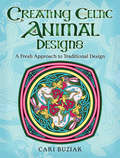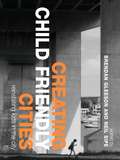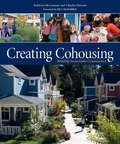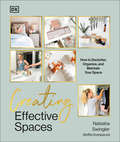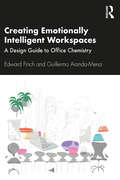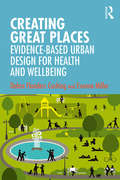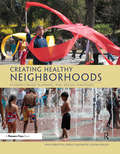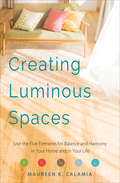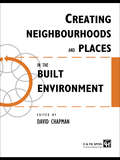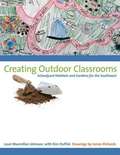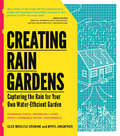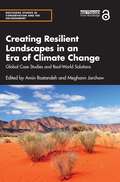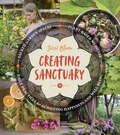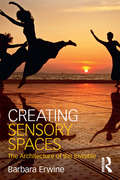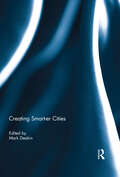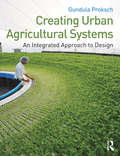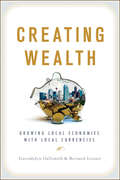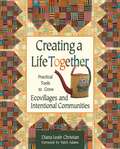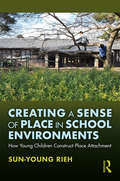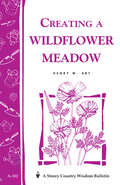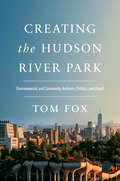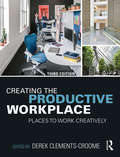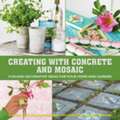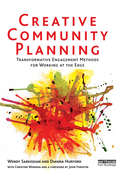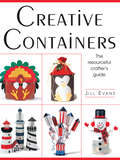- Table View
- List View
Creating Celtic Animal Designs: A Fresh Approach to Traditional Design
by Cari BuziakMany instruction books just teach how to duplicate designs without providing any clues for the next step — making your own! This unique guide features the highly effective Aon method, a technique for creating your own original designs rather than copying examples. It's easy to comprehend, with simple step-by-step instructions that focus on incorporating animal forms into Celtic patterns and designs.Creating Celtic Animal Designs builds on author Cari Buziak's experience teaching and writing about Celtic patterns and their creation, meaning, and history. Her nine in-depth examples encompass both traditional and contemporary renderings of animals — hounds, lions, hares, birds, and other creatures. Cari demonstrates the freehand drawing of Celtic knots and moves beyond the basics to show how to manipulate and develop stand-alone patterns into panels and combinations. Artists, designers, art instructors, tattoo artists, and anyone who appreciates Celtic designs will find this book a treasury of both instruction and inspiration.
Creating Child Friendly Cities: New Perspectives and Prospects
by Neil Sipe Brendan GleesonFirst Published in 2006. Routledge is an imprint of Taylor & Francis, an informa company.
Creating Cohousing
by Kathryn Mccamant Charles DurrettCohousing balances privacy and independence with the benefits of living in community. This completely revised and updated third edition of the "cohousing bible" invites readers into these sustainable neighborhoods, and provides practical tools for developing their own.
Creating Effective Spaces: Declutter, Organize and Maintain Your Space
by Natasha SwinglerAn effective space is one that works for you, liberating you to live the life you want. Natasha Swingler’s decluttering and organization solutions save time, space, and look amazing!Natasha takes you around the home and shares her hacks from the kitchen to the bedroom via the office and hallway. Never again will you need to step over your "floordrobe", rifle through the shoe rack, or spend ten minutes searching for keys.Applying Natasha’s "house rules" to every room, drawer, and cupboard, you’ll learn to ditch the complex systems, keep things where you use them, and set all-important boundaries throughout your home. Taking the questionnaire at the start of the book will reveal the priorities for your living space. Then, by implementing daily routines, simple systems, and practical processes tailored to your needs, you will create an ideal stress-free environment that looks good, too.With beautiful photography throughout, and step-by-step diagrams of folds for everything from towels and T-shirts to gift-wrap, Natasha’s system for creating a serene home can be applied to any space, large or small.
Creating Emotionally Intelligent Workspaces: A Design Guide to Office Chemistry
by Edward Finch Guillermo Aranda-MenaEmotions in the workplace have until recently been seen simply as a distraction. We often think of work as rational, logical and non-emotional. But organisations are waking up to the key role of emotions and affect at work. Emotions influence how we make decisions, how we relate with one another and how we make sense of our surroundings. Whilst organisations are slowly embracing the pivotal role of emotions, designers and managers of workplaces have been struggling to keep up. New insights from hard sciences such as neuropsychology are presenting a radically different interpretation of emotions. Yet workplace designers and facilities managers still rely on measuring non-specific states such as satisfaction and stress. In this book we attempt to capture modern-day interpretations of emotion, looking at emotion in terms of transactions and processes rather than simple cause and effect. We entertain the idea of an ‘emotionally intelligent building’ as an alternative to the much-hyped intelligent building. The assertion is that we should create environments that are emotionally intelligent. Rather than focusing on the aptitudes or shortcomings of individuals at work, we should place closer attention on the office environment. It’s not that we are emotionally disabled – it’s the environment that disables us! The ability of you and me to interpret, control and express emotions may not simply be a result of our own make-up. A radically different outlook considers how our workspace and workplace debilitates or enables our emotional understanding. In the modern workplace there are many innovations that can undermine our emotional intelligence, such poorly implemented hot-desking or lean environments. Contrariwise there are key innovations such as Activity Based Working (ABW) that have the potential to enhance our emotional state. Through a series of unique case studies from around the world, we investigate key concepts that can be used by designers and facilities managers alike. No longer should designers be asked to incorporate emotional elements as intangible un-costed ‘add-ons’. This book provides a shot in the arm for workplace design professionals, pointing to a new way of thinking based on the emotional intelligence of the workplace.
Creating Great Places: Evidence-based Urban Design for Health and Wellbeing
by Debra Flanders Cushing Evonne MillerThis book provides a bold vision and roadmap for creating great places. Imagining and designing urban environments where all people thrive is an extraordinary task, and in this compelling narrative, Cushing and Miller remind us that theory is a powerful starting point. Drawing on international research, illustrated case studies, personal experiences, as well as fascinating examples from history and pop culture, this practical book provides the reader with inspiration, guidance and tools. The first section outlines six critical theories for contemporary urban design - affordance, prospect-refuge, personal space, sense of place/genius loci, place attachment, and biophilic design. The second section, using their innovative ‘theory-storming’ process, demonstrates how designers can create great places that are inclusive, sustainable, and salutogenic. Creating Great Places is an insightful, compelling, and evidence-based resource for readers who want to design urban environments that inspire, excite, and positively transform people’s lives.
Creating Healthy Neighborhoods: Evidence-Based Planning and Design Strategies
by Ann Forsyth Emily Salomon Laura SmeadGood housing. Easy transit. Food access. Green spaces. Gathering places. Everybody wants to live in a healthy neighborhood. Bridging the gap between research and practice, it maps out ways for cities and towns to help their residents thrive in placed designed for living well, approaching health from every side – physical mental, and social.
Creating Luminous Spaces: Use the Five Elements for Balance and Harmony in Your Home and in Your Life
by Maureen K. CalamiaAncient and global modern design come together in this practical guide to interior design, biophilic design, and feng shui for your home. Part spiritual growth workbook and part treatise on the power of nature, Creating Luminous Spaces is your practical guide to giving your home a refreshing energy boost. In this inventive approach to interior design, Maureen K. Calamia blends modern trends with the five elements of feng shui, an ancient Chinese system that brings the cycles and benefits of nature to your home interior. With inspiring ideas and practical information, Calamia will help you discover which of nature&’s elements represents your energy. Should you enhance your home with natural light or a fish bowl? New organizational habits or tall, vertical lines? Featuring practical exercises, meditations, and real stories about clients and students, as you embark on this mind-body-spirit connection with your home, you&’ll find out how: Indoor lighting and lighting design can strengthen the fire elementOrganizational behavior is influenced by the metal elementSpace planning with plants nourishes the wood elementAnd more!
Creating Neighbourhoods and Places in the Built Environment (Built Environment Series Of Textbooks Ser.)
by David ChapmanThis design primer examines the forces at work in the built environment and their impact on the form of buildings and their environments. The actions of a range of individuals and agencies and the interaction between them is examined, exploring the competing interests which exist, their interaction with physical and environmental forces and the uncertain results of both individual and corporate intervention.
Creating Outdoor Classrooms
by Lauri Macmillan JohnsonSchoolyards have come a long way from the barren playgrounds that many people remember. Today's school campuses often feature gardens in which students can learn about native plants and wildlife, grow vegetables and fruit, explore cultural traditions, practice reading and math skills, and use their imaginations to create fun play spaces. And for a growing number of urban students, these schoolyard gardens offer the best, if not the only, opportunity to experience the natural world firsthand and enjoy its many benefits. This book is a practical, hands-on guide for creating a variety of learning environments in the arid Southwest. Filled with clear, easy-to-use information and illustrated with photographs, drawings, and plans, the book covers everything necessary to create schoolyard gardens:- An introduction to schoolyards as outdoor classrooms and several types of habitats, including art gardens, cultural history gardens, ecological gardens, literacy gardens, and vegetable gardens- Design theory, including a history of garden styles, and design principles and design elements- Beginning the design process, including identifying participants and writing a design program that sets out goals and requirements- Conducting site research and synthesizing design elements to arrive at a final design- Design essentials, including project funding and design features, maintenance, accessibility, safety, and project evaluation and revision- Wildlife ecology, including elements needed for survival such as food and shelter- Creating gardens for pollinators and other wildlife, including hummingbirds, butterflies, bees, moths, bats, and flies, as well as pest control- Lists of native plants for various kinds of habitats and nurseries that sell native plants, as well as books, web sites, and other resources for learning more about native plants and wildlifeThis guide will be essential for landscape architects, school personnel, parents, and students. Indeed, its principles can be used in designing schoolyard habitats across the country, while its information on gardening with native plants and wildlife will be useful to homeowners across the Southwest.
Creating Rain Gardens: Capturing the Rain for Your Own Water-Efficient Garden
by Apryl Uncapher Cleo Woelfle-ErskineHomeowners spend hundreds of dollars watering their yard, but there is an easy way to save money and resources—rain gardening. But what is it? As simple as collecting rain to reuse in front and backyards. Creating Rain Gardens is a comprehensive book for the DIY-er, covering everything from rain barrels to simple living roofs, permeable patios, and other low-tech affordable ways to save water in the garden. Water conservation experts Cleo Woelfle-Erskine and Apryl Uncapher walk homeowners through the process, with step-by-step instructions for designing and building swales, French drains, rain gardens, and ephemeral ponds—the building blocks of rain-catching gardens. From soil preparation, planting, troubleshooting, and maintenance, to selecting palettes of water-loving plants that provide four-season interest and a habitat for wildlife, Creating Rain Gardens covers everything a gardener needs to create a beautiful rain garden at home.
Creating Resilient Landscapes in an Era of Climate Change: Global Case Studies and Real-World Solutions (Routledge Studies in Conservation and the Environment)
by Amin Rastandeh Meghann JarchowThis book delivers a realistic and feasible framework for creating resilient landscapes in an era of anthropogenic climate change. From across six continents, this book presents fifteen case studies of differing sociocultural, economic, and biophysical backgrounds that showcase opportunities and limitations for creating resilient landscapes throughout the world. The potential to create socio-ecological resilience is examined across a wide range of landscapes, including agricultural, island, forest, coastal, and urban landscapes, across sixteen countries: Argentina, Australia, Brazil, Denmark, Finland, Greece, Guatemala, Japan, Mexico, Norway, Samoa, South Africa, the United States, Turkey, Uruguay, and Vanuatu. Chapters discuss current and future issues around creating a sustainable food system, conserving biodiversity, and climate change adaptation and resilience, with green infrastructure, nature-based architecture, green-tech, and ecosystem services as just a few of the approaches discussed. The book emphasizes solution-oriented approaches for an "ecological hope" that can support landscape resiliency in this chaotic era, and the chapters consider the importance of envisioning an unpredictable future with numerous uncertainties. In this context, the key focus is on how we all can tackle the intertwined impacts of climate change, biodiversity loss, and large-scale land-cover conversion in urban and non-urban landscapes, with particular attention to the concept of landscape resiliency. The volume provides that much-needed link between theory and practice to deliver forward-thinking, practical solutions. This book will be of great interest to students, researchers, practitioners and policymakers who are interested in the complex relationship between landscapes, climate change, biodiversity loss, and land-based conversion at local, national and global scales.
Creating Sanctuary: Sacred Garden Spaces, Plant-Based Medicine, and Daily Practices to Achieve Happiness and Well-Being
by Jessi Bloom Shawn Linehan“In this beautiful, inspiring, and hands-on, practical book we are invited to look deeply at the landscape around us and create sacred respites from our busy worlds.” —Rosemary Gladstar, herbalist and author We all need a personal sanctuary where we can be in harmony with the natural world and can nurture our bodies, minds, and souls. And this sanctuary doesn’t have to be a far-away destination—it can be in your own backyard. In Creating Sanctuary, Jessi Bloom taps into multiple sources of traditional plant wisdom to help find a deeper connection to the outdoor space you already have—no matter the size. Equal parts inspirational and practical, this engaging guide includes tips on designing a healing space, plant profiles for 50 sacred plants, recipes that harness the medicinal properties of plants, and simple instructions for daily rituals and practices for self-care. Hands-on, inspiring, and beautiful, Creating Sanctuary is a must-have for finding new ways to revitalize our lives.
Creating Sensory Spaces: The Architecture of the Invisible
by Barbara ErwineCreating Sensory Spaces celebrates spaces enlivened with sensual richness and provides you with the knowledge and tools necessary to create them. Drawing on numerous built case studies in ten countries and illustrated with over 85 full color images, the book presents a new framework for the design of sensory spaces including light, color, temperature, smell, sound, and touch. Bridging across disciplines of architecture, engineering, phenomenology and perceptual psychology, this book informs the design of buildings and neighborhoods that reclaim the role of the body and all the senses in creating memorable experiences of place and belonging.
Creating Smart-er Cities
by Mark DeakinDrawing upon the smart experiences of "world class" cities in North America, Canada and Europe, this book provides the evidence to show how entrepreneurship-based and market-dependent representations of knowledge production are now being replaced with a community of policy makers, academic leaders, corporate strategists and growth management alliances, with the potential to liberate cities from the stagnation which they have previously been locked into by offering communities: the freedom to develop polices, with the leadership and strategies capable of reaching beyond the idea of "creative slack"; a process of reinvention, whereby cities become "smarter," in using intellectual capital to not only meet the efficiency requirements of wealth creation, but to become centres of creative slack; the political leadership capable of not only being economically innovative, or culturally creative, but enterprising in opening-up, reflexively absorbing and discursively shaping the democratic governance of such developments; the democratic governance to sustain such developments. Drawing together the critical insights from papers from a collection of leading international experts on the transition to smart cities, this book proposes to do what has recently been asked of those responsible for creating Smarter Cities. That is: provide the definitional components, critical insights and institutional means by which to get beyond the all too often self-congratulatory tone cities across the world strike when claiming to be smart and by focussing on the critical role master-plans and design codes play in supporting the sustainable development of communities.This book was published as a special issue of Urban Technology.
Creating Urban Agricultural Systems: An Integrated Approach to Design
by Gundula ProkschCreating Urban Agriculture Systems provides you with background, expertise, and inspiration for designing with urban agriculture. It shows you how to grow food in buildings and cities, operate growing systems, and integrate them with natural cycles and existing infrastructures. It teaches you the essential environmental inputs and operational strategies of urban farms, and inspires community and design tools for innovative operations and sustainable urban environments that produce fresh, local food. Over 70 projects and 16 in-depth case studies of productive, integrated systems, located in North America, Europe, and Asia ,are organized by their emphasis on nutrient, water, and energy management, farm operation, community integration and design approaches so that you can see innovative strategies in action. Interviews with leading architecture firms, including WORKac, Kiss + Cathcart, Weber Thompson, CJ Lim/Studio 8, and SOA Architectes, highlight the challenges and rewards you face when creating urban agriculture systems. Catalogs of growing and building systems, a glossary, bibliography, and abstracts will help you find information fast.
Creating Wealth
by Bernard Lietaer Gwendolyn HallsmithLocal currencies have been introduced in thousands of communities around the world in response to the economic crisis because they offer an alternative to money as a way of meeting important human needs. Community leaders can mobilize assets using complementary currencies to address social and economic issues including health care, education, elder care, environmental problems, housing, and food security.
Creating a Life Together
by Patch Adams Diana Leafe ChristianCreating a Life Together is the only resource available that provides step-by-step practical information distilled from numerous firsthand sources on how to establish an intentional community. It deals in depth with structural, interpersonal and leadership issues, decision-making methods, vision statements, and the development of a legal structure, as well as profiling well-established model communities. This exhaustive guide includes excellent sample documents among its wealth of resources.Diana Leafe Christian is the editor of Communities magazine and has contributed to Body & Soul, Yoga Journal, and Shaman's Drum, among others. She is a popular public speaker and workshop leader on forming intentional communities, and has been interviewed about the subject on NPR. She is a member of an intentional community in North Carolina.
Creating a Sense of Place in School Environments: How Young Children Construct Place Attachment
by Sun-Young RiehCreating a Sense of Place in School Environments guides its readers to the characteristics that tend to generate a sense of place through children’s vivid descriptions of their school and provides a body of critical information that can be employed to design a better school environment that can imprint cherished childhood memories. The childhood school environment calls for special attention regarding the sense of place it creates. The sense of place in childhood both affects children's current quality of life and frames their lasting world view. It is well known that children's cognitive development is closely related to their place attachment to their surroundings, and that children’s adaptation to a given environment depends on how such place attachment can be created. Therefore, it is natural that people’s identity in the world is the accumulation of their experience of place while in childhood. Cross-checking between the imprint of adults' memories of places in school and children’s current "lived experience" of their favorite school place confirmed that certain spatial configurations, which the author herein refers to as "place generators" can generate positive attributes of physical settings that construct a sense of place and last as lifelong memories. It is an ideal read for academics, students, and professionals.
Creating a Wildflower Meadow: Storey's Country Wisdom Bulletin A-102
by Henry W. ArtSince 1973, Storey's Country Wisdom Bulletins have offered practical, hands-on instructions designed to help readers master dozens of country living skills quickly and easily. There are now more than 170 titles in this series, and their remarkable popularity reflects the common desire of country and city dwellers alike to cultivate personal independence in everyday life.
Creating the Hudson River Park: Environmental and Community Activism, Politics, and Greed
by Tom FoxThe 4-mile-long, 550-acre Hudson River Park is nearing completion and is the largest park built in Manhattan since Central Park opened more than 150 years ago. It has transformed a derelict waterfront, protected the Hudson River estuary, preserved commercial maritime activities, created new recreational opportunities for millions of New Yorkers, enhanced tourism, stimulated redevelopment in adjacent neighborhoods, and set a precedent for waterfront redevelopment. The Park attracts seventeen million visitors annually. Creating the Hudson River Park is a first-person story of how this park came to be. Working together over three decades, community groups, civic and environmental organizations, labor, the real estate and business community, government agencies, and elected officials won a historic victory for environmental preservation, the use and enjoyment of the Hudson River, and urban redevelopment. However, the park is also the embodiment of a troubling trend toward the commercialization of America’s public parks. After the defeat of the $2.4 billion Westway plan to fill 234 acres of the Hudson in 1985, the stage was set for the revitalization of Manhattan’s West Side waterfront. Between 1986 and 1998 the process focused on the basics like designing an appropriate roadway, removing noncompliant municipal and commercial activities from the waterfront, implementing temporary improvements, developing the Park’s first revenue-producing commercial area at Chelsea Piers, completing the public planning and environmental review processes, and negotiating the 1998 Hudson River Park Act that officially created the Park. From 1999 to 2009 planning and construction were funded with public money and focused on creating active and passive recreation opportunities on the Tribeca, Greenwich Village, Chelsea, and Hell’s Kitchen waterfronts. However, initial recommendations to secure long term financial support for the Park from the increase in adjacent real estate values that resulted from the Park’s creation were ignored. City and state politicians had other priorities and public funding for the Park dwindled. The recent phase of the project, from 2010 to 2021, focused on “development” both in and adjacent to the Park. Changes in leadership, and new challenges provide an opportunity to return to a transparent public planning process and complete the redevelopment of the waterfront for the remainder of the 21st-century. Fox’s first-person perspective helps to document the history of the Hudson River Park, recognizes those who made it happen and those who made it difficult, and provides lessons that may help private citizens and public servants expand and protect the public parks and natural systems that are so critical to urban well-being.
Creating the Productive Workplace: Places to Work Creatively
by Derek Clements-CroomeThe built environment affects our physical, mental and social well-being. Here renowned professionals from practice and academia explore the evidence from basic research as well as case studies to test this belief. They show that many elements in the built environment contribute to establishing a milieu which helps people to be healthier and have the energy to concentrate while being free to be creative. The health and well-being agenda pervades society in many different ways but we spend much of our lives in buildings, so they have an important role to play within this total picture. This demands us to embrace change and think beyond the conventional wisdom while retaining our respect for it. Creating the Productive Workplace shows how we need to balance the needs of people and the ever-increasing enabling technologies but also to take advantage of the healing powers of Nature and let them be part of environmental design. This book aims to lead to more human-centred ways of designing the built environment with deeper meaning and achieve healthier and more creative, as well as more productive places to work.
Creating with Concrete and Mosaic: Fun and Decorative Ideas for Your Home and Garden
by Sania Hedengren Susanna ZackeCasting in concrete is an exciting project that is both enjoyable and practical. You can create all sorts of decorations and furniture for your home that are sure to be the envy of all your neighbors. But the fun doesn’t have to stop there! Concrete lends itself to many unique and exquisite projects, and decorating these pieces with beautiful mosaic patterns makes them all the more impressive. Here, interior decorating journalists and stylists Sania and Susanna show you how to do that. Decorating with mosaic and pouring concrete are both addictive; once you start, you won’t want to stop. With step-by-step photos and instructions, Sania and Susanna show you how to create more than twenty different decorations and ornate trinkets. Whether you’re someone looking to create a new decoration for your home or a fledgling concrete caster, this book has a little something for everyone. The sky is the limit! Let your imagination run wild, and be inspired!
Creative Community Planning: Transformative Engagement Methods for Working at the Edge (Earthscan Tools For Community Planning Ser.)
by Wendy Sarkissian Christine WenmanCreative Community Planning provides clear access to emerging innovations in artistic, narrative, embodied and technological methods. Reflecting on the wide continuum of participatory practice, the authors explore the frontiers of community engagement within a fresh sustainability framework. Leading planning theorists, researchers and practitioners in the field reflect with the authors on the many successes and challenges in engaging with a diversity of people in rural and urban communities. These conversations reveal creativity as key to enhancing existing engagement practices. Concepts and practical applications thread through the book, including community visioning, participatory research and reporting, conflict resolution, poetry and planning language, theatre, photography, film and websites.
Creative Containers: The Resourceful Crafter's Guide
by Jill EvansFast, fun and easy projects to make with recycled materials! Author and designer Jill Evans has created 50 great projects made from recycled containers, all of which are perfect for crafters of any skill level, even children! Ranging from a darling penguin for Christmas and a kooky witch for Halloween to home decor items like lighthouses and candleholders, crafters will find creative ideas for any occasion. And, the best thing is, each project can be completed using common craft tools and materials for less than $5! Full-size patterns are included for each project, and readers will use food cans, potato chip canisters, beverage cups, and cookie tins to make these functional and earth-friendly pieces!
